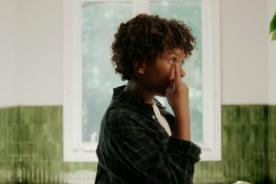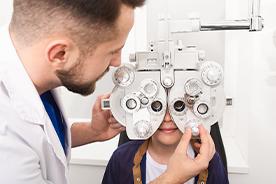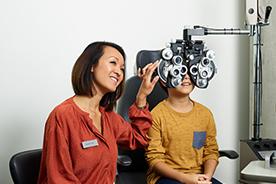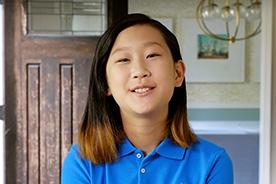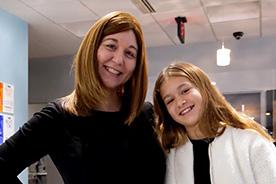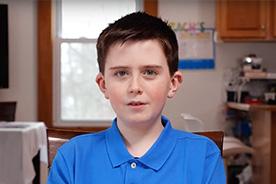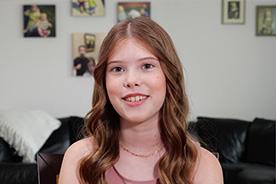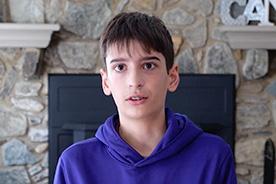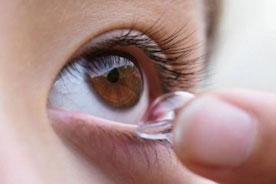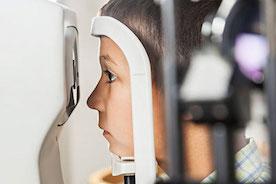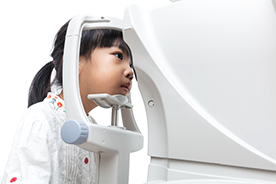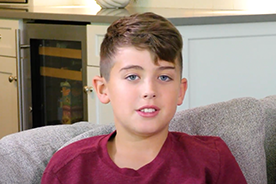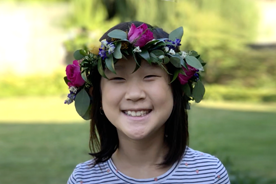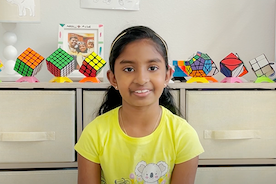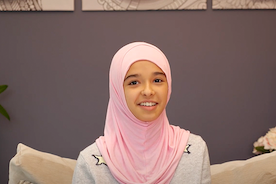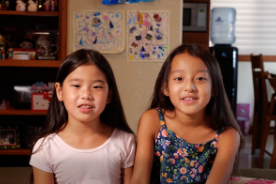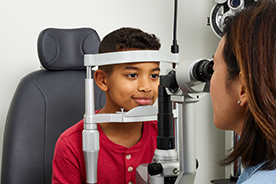If you’ve heard of myopia, you probably already know it has something to do with vision—even if you’re unsure exactly what it is. Myopia is a common vision condition in children, and it’s important that parents understand what myopia is and its development, its warning signs and symptoms, the potential risks if left untreated, and which solutions and options are available for children with myopia to improve their eyesight both now and in the future.
Myopia by Definition
Myopia is a condition that makes it difficult to see things clearly in the distance. Chances are, you’ve heard it called nearsightedness or shortsightedness, because myopic eyes can see close-up more easily. But if your child has to squint to see things farther away, they could have myopia.
Why does myopia happen? Because the eye is growing faster than it should and longer than it should. When that happens, the eye becomes weaker, leading to vision problems.
For perfect vision, light must focus directly on the tissue that lines the back of the eye, called the retina. Since the eye is longer with myopia, light focuses in front of the retina which causes a blurry image when viewing objects in the distance. This is like when a camera is out of focus. The child may squint to help see distant objects, and could experience side effects such as headaches, eyestrain and fatigue.
It’s important for parents to understand how their child with myopia sees the world, and how myopic vision looks and feels. But it’s even more important to know that it’s something that can be treated safely and effectively.
Warning Signs and Symptoms
Myopia—or nearsightedness—is diagnosed by your child’s eye care provider, but the signs and symptoms for parents to look out for include blurry vision when looking at distant objects, squinting to see clearly, headaches and eyestrain. Children might also struggle to see their classroom’s whiteboards or screens.
For younger children, telling a caregiver about vision problems could look different. In addition to squinting, behaviors like blinking excessively, rubbing their eyes, sitting close to the TV and seeming unaware of objects in the distance could be an indication of myopia. Younger children might not complain about blurry vision, which makes eye exams and vision tests a critical part of diagnosing myopia. And because myopia can be present at birth or develop as the child grows, it’s important to ensure an eye care provider and comprehensive eye exams are a part of their regular medical visits.
An important note: myopia can also be a sign of a more serious underlying cause,1 so it’s important to have regular medical checkups to help rule out other causes.
Genetics Play a Role in the Diagnosis
It’s important to understand myopia development, because myopia has no single cause. Rather, both genetics2 and lifestyle3,4,5 contribute to the eye growing longer than it should. For example, myopia tends to run in families, meaning children are more likely to have myopia if their parents do. However, children still have a 1 in 4 chance of developing myopia even when neither parent has myopia; therefore, genetics isn’t the whole story.6
More Contributing Factors for Myopia
Myopia usually develops in childhood, around ages 5 to 14, and continues to worsen until early adulthood. The eye tends to grow most rapidly during childhood, and myopia onset at a younger age is associated with more rapid progression.7 The American Academy of Ophthalmology notes that too much time indoors can increase a child’s risk for nearsightedness, while studies show that more time outdoors in natural light reduces that risk.8
Your Child Isn’t Alone: Myopia is on the Rise
The number of people with myopia has been on the rise for decades. In the early 1970s, the prevalence of myopia in the U.S. was around 25%. By 2000, that number had exceeded 40%9—and it continues to rise. Furthermore, experts predict myopia will affect nearly 50% of the world’s population by 2030.10
So what caused U.S. myopia rates to increase so quickly? Theories include spending less time outdoors (and thereby being exposed to less bright light), and working on computers and other near devices that demand close-up focusing.3,4,5
Delaying the Onset of Myopia
The good news is, there are proven ways to slow the progression of myopia—in addition to getting a prescription when necessary. That means you have the power to help protect your child’s vision from getting worse. Eye care professionals recommend spending time outdoors, reducing screen time, modifying how close kids are to their screens and using correction methods for myopia. Spending time outdoors is the top (non-product) lifestyle recommendation that ECPs give to parents, recommending it to 60% of their pediatric myopes. However, only about a quarter of parents recall this recommendation.11 Dr. Justin Kwan, OD, FAAO, Senior Manager of Myopia Management at CooperVision, recommends taking children on errands out of the home to help reduce the risk of developing myopia. Even in that short time, they’ll be outside a little more than they would be otherwise.
When it comes to correcting vision and controlling your child’s nearsightedness, it’s important to choose the right products. Standard contact lenses and glasses will correct vision, but not slow down the progression of myopia. However, there are products scientifically shown to slow vision from getting worse. Early intervention is key because myopia progresses more quickly in younger children, since they’re growing and developing quickly.7 That’s why 92% of eye care professionals agree it’s important to address children’s eye conditions and slow myopia progression as early as possible—ideally before they turn 10.11҂
Only FDA-Approved Myopia Management Tool for Children
As a parent, you need options that fit easily into your child’s life, and most eye care professionals agree that today’s contact lenses can do just that. Until recently, traditional glasses and contact lenses in the U.S. were developed only to correct blurred vision. That all changed with the introduction of MiSight® 1 day, a contact lens that’s clinically proven to slow the progression of myopia in age-appropriate children.12 These daily wear, single-use contact lenses are the first and only± FDA-approved* lenses to slow the progression of myopia when prescribed for children 8-12 years old at the initiation of treatment.12†
Not surprisingly, 84% of eye care professionals would consider putting children with myopia into contact lenses that can help slow the progression of myopia.11 And on average, they’re comfortable fitting young children,11 which means you can confidently get your child the safe and reliable help they need as soon as possible. Even better, 88% of age-appropriate children say they prefer wearing MiSight® 1 day contact lenses over glasses.13
If you’re unsure whether your child has the skills to use contact lenses, there’s good news there, too: 90% of age-appropriate children are able to insert and remove their MiSight® 1 day contact lenses on their own.12§ That being said, lenses should not be worn unsupervised.
As children grow, their prescription often gets worse. But it doesn’t have to. Now you can make the best plan with your doctor to help your child improve their eyes and their life.
Your Prescription Isn’t “Bad,” It’s Just Bad for Your Age
“If you have a minus-one 22-year-old, we can celebrate that,” CooperVision Senior Manager of Myopia Management Dr. Justin Kwan, OD, FAAO, says. “But if we have a minus-one kindergartener, we need to get on top of that, because they’re growing so fast.”
His point is clear: A diagnosis of low myopia in a young child may not seem so bad, but it can get worse with age, which is why early intervention is key to slowing myopia’s progression.7
Contact Lenses for Children? Is This Safe?
The good news for children with blurred vision—both now and in the future—is that MiSight® 1 day has a strong safety profile and it's a 1-day lens.14
Studies have shown that kids as young as 8 years old can successfully wear daily disposable soft contact lenses.12‡ One study that tracked lens wearers for more than a decade found that “successful contact lens wearers fit as children are no more likely to report previous contact lens-related adverse events, problems with compliance, decreased wearing time, or worse ocular health than those fit as teenagers, so practitioners should not use age as a primary determinant in fitting children in contact lenses.”15
Of course, studies are about averages. What about your child? Is he or she ready for contacts? Here are a few questions to help you decide whether your child is ready to be fit—and if they are, to help you start thinking about creating a successful experience with contact lenses:
- Assess: Is your child responsible enough? Does your child keep their room clean and remember daily responsibilities, for the most part? Are they generally good at keeping track of things, including schedules? If so, they’re likely ready for the daily care that contacts require.
- What kind of contact lenses work best? For most contact lens wearers—especially children—daily disposable lenses are the way to go. Not only do wearers not need to worry about cleaning, storing and disinfecting their contacts after they remove them, but it’s also not as big a deal if they lose a lens or two here or there along the way. There will always be another fresh pair ready for the next day.
- Is it worth it? Getting contact lenses takes some effort from parents, as well as from the kids getting them, including the regular checkups your child will need to have with their eye care professional. But most families find that any initial time investment is more than worth it. Kids usually find that they’re happier wearing contacts. In one study, kids wearing contacts instead of eyeglasses self-reported the following16:
- Felt more competent when participating in sports and other physical activities
- Felt better about their appearance
- Felt better about fitting in with their friends
- How can this benefit my child? Consider your child’s lifestyle and how contact lenses may improve the convenience and ability to perform physical activities. In addition to the vision12,17¶ and eye health benefits18♦ MiSight® 1 day contact lenses can have for your child, they can also offer the benefit of being glasses-free to interact with the world.
Can Contacts Actually Keep My Child’s Myopia from Getting Worse? Some Can.
MiSight® 1 day contact lenses are the first and only± FDA-approved* soft contact lenses proven to slow the progression of myopia in children aged 8-12 at the initiation of treatment.12†
There are many aspects of the lens wearing experience that require making decisions as a family. But whatever decision you make right now, you can be sure your child’s contact lenses have a strong safety profile14—while correcting nearsightedness12† and providing additional lifestyle benefits.
Schedule Regular Eye Exams, Even at a Young Age
It can be difficult for both children and adults to recognize gradual vision changes. That’s why the Mayo Clinic—in addition to the American Academy of Ophthalmology and American Academy of Optometry—recommends screening children for vision problems20:
- At least once between ages 3 and 5
- Before kindergarten, usually age 5 or 6
- Annually through the end of high school
Whether or not your child complains about not being able to clearly see objects in the distance——like the board at the front of their classroom—they should have annual comprehensive eye exams to check for myopia and other eye conditions that may not have signs or symptoms.
If Left Untreated, There Are Risks
Here are some of the conditions people with myopia are at greater risk of developing:19
Glaucoma
This progressive condition occurs due to increased pressure in the eye that can lead to permanent vision loss or blindness by causing damage to the optic nerve. Glaucoma is a leading cause of vision loss among those over age 60, and regular eye exams are important for early diagnosis and treatment, especially among those at a higher risk.
Cataracts
Cataracts occur when the lens inside the eye becomes cloudy over time, making vision blurry in a way that glasses and contact lenses can’t fix. Myopia increases the risks of developing cataracts earlier in life. Studies have found that those who have had severe myopia that occurs before age 20 are at a higher risk of developing cataracts, but the reasons for this aren’t clear.21 One theory is that the increased eyeball length caused by myopia makes it harder to deliver nutrients to the back of the lenses, increasing the risk of developing cataracts.
Retinal tears
The retina, which is tissue that lines the inside of the eye and helps us see, is more prone to tearing when it’s thinner and becomes stretched with the lengthening of the eye from myopia. Retinal tears can lead to vision loss, and large tears can lead to a retinal detachment, which can cause permanent vision loss or blindness.
Retinal detachment
This condition occurs when the retina moves away from its location at the back of the eye. A major symptom of retinal detachment is a sudden change in vision, such as an increase in “floaters” or small black spots or lines, a “curtain or veil” appearance, or “flashes”, like a camera flickering in your eye.21 Unless treated quickly, retinal detachment can lead to permanent vision loss, so it’s important to visit an eye care professional without delay if you notice symptoms.
Myopic maculopathy
This can happen when the elongation of the eye causes a breakdown in the macula, a region of the eye that provides clear central vision.
Not everyone with myopia will experience these serious vision conditions. However, the risks of them developing increases significantly with worsening myopia. Therefore, regular eye exams are essential to ensure your eyes remain as healthy as possible, and that any potential problems can be treated early, when treatments are usually most effective.
Next Steps
Make an appointment with your child’s eye care professional. 82% of eye care professionals say they worry that pediatric patients will have significant eye health issues later in their life.12** That’s because children’s myopia progresses as they grow, which can lead to future eye health problems. Even children with fairly low prescriptions have a higher risk of glaucoma and retinal detachment than non-myopic children, and that risk multiplies as prescriptions get stronger.22
You can find a MiSight® eye doctor in your area who’s experienced in the treatment of childhood myopia by clicking here.
More Reading
Dr. Justin Kwan, Sr. Manager of Myopia Management at CooperVision, answered the most frequently asked questions about childhood myopia’s causes and possible treatment with MiSight® 1 day soft contact lenses.




